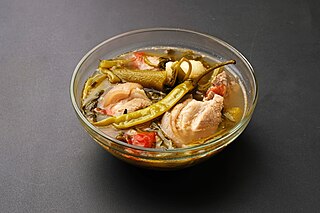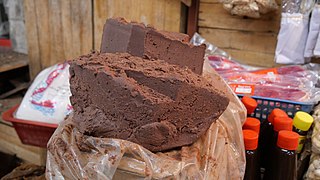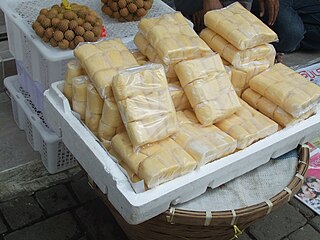
Lactic acid fermentation is a metabolic process by which glucose or other six-carbon sugars are converted into cellular energy and the metabolite lactate, which is lactic acid in solution. It is an anaerobic fermentation reaction that occurs in some bacteria and animal cells, such as muscle cells.

Prahok is a salted and fermented fish paste used in Cambodian cuisine as a seasoning or a condiment. It originated as a way of preserving fish during the months when fresh fish was not available in abundant supply. Because of its saltiness and strong flavor, it was used as an addition to many meals in Cambodian cuisine, such as soups and sauces. A Cambodian saying goes, "No prahok, no salt", referring to a dish that is of poor flavor or bland thus highlighting its essentiality in Cambodian cuisine.

Bagoóng is a Philippine condiment partially or completely made of either fermented fish or krill or shrimp paste with salt. The fermentation process also produces fish sauce known as patís.

The history of sushi began with paddy fields, where fish was fermented with vinegar, salt and rice, after which the rice was discarded. The earliest form of the dish, today referred to as narezushi, was created in Japan around the Yayoi period. In the Muromachi period (1336–1573), people began to eat the rice as well as the fish. During the Edo period (1603–1867), vinegar rather than fermented rice began to be used. The dish has become a form of food strongly associated with Japanese culture.

Filipino cuisine is composed of the cuisines of more than a hundred distinct ethnolinguistic groups found throughout the Philippine archipelago. A majority of mainstream Filipino dishes that compose Filipino cuisine are from the food traditions of various ethnolinguistic groups and tribes of the archipelago, including the Ilocano, Pangasinan, Kapampangan, Tagalog, Bicolano, Visayan, Chavacano and Maranao ethnolinguistic groups. The dishes associated with these groups evolved over the centuries from a largely indigenous base shared with maritime Southeast Asia with varied influences from Chinese, Spanish and American cuisines, in line with the major waves of influence that had enriched the cultures of the archipelago and adapted using indigenous ingredients to meet local preferences.

Sinigang is a Filipino soup or stew characterized by its sour and savory taste. It is most often associated with tamarind, although it can use other sour fruits and leaves as the souring agent. It is one of the more popular dishes in Filipino cuisine. The soup is usually accompanied by rice. In 2021, sinigang was rated as the world's best vegetable soup by TasteAtlas. In December 2023, the website project's TasteAtlas Awards 2023/24 included sinigang among its "100 best dishes in the world".

Burong mangga is a Filipino side dish made by mixing sugar, salt, and water to mangoes that have previously been salted. The mixture of water and sugar should be boiled and cooled first, before pouring it over the salted mangoes. Some variants add chilis to the cooled sugar water mixture. Original "basic" burong mangga is made using a brine solution and pouring it over halved unripe or partially ripe mangoes. Mango cultivars commonly used for burong mangga include 'Carabao' mangoes and 'Pico' mangoes.

Shrimp paste or prawn sauce is a fermented condiment commonly used in Southeast Asian and Southern Chinese cuisines. It is primarily made from finely crushed shrimp or krill mixed with salt, and then fermented for several weeks. They are either sold in their wet form or are sun-dried and either cut into rectangular blocks or sold in bulk. It is an essential ingredient in many curries, sauces and sambal. Shrimp paste can be found in many meals in Cambodia, Indonesia, Laos, Malaysia, Myanmar, the Philippines, Singapore, Thailand, and Vietnam. It is often an ingredient in dip for fish or vegetables.

The generic term for condiments in the Filipino cuisine is sawsawan. Unlike sauces in other Southeast Asian regions, most sawsawan are not prepared beforehand, but are assembled on the table according to the preferences of the diner.

Red yeast rice, red rice koji, red fermented rice, red kojic rice, red koji rice, anka, or angkak, is a bright reddish purple fermented rice, which acquires its color from being cultivated with the mold Monascus purpureus. Red yeast rice is what is referred to as a "koji" in Japanese, meaning "grain or bean overgrown with a mold culture", a food preparation tradition going back to ca. 300 BC. In both the scientific and popular literature in English that draws principally on Japanese traditional use, red yeast rice is most often referred to as "red rice koji." English language articles favoring Chinese literature sources prefer the translation "red yeast rice."

Tapai is a traditional fermented preparation of rice or other starchy foods, and is found throughout much of Southeast Asia, especially in Austronesian cultures, and parts of East Asia. It refers to both the alcoholic paste and the alcoholic beverage derived from it. It has a sweet or sour taste and can be eaten as is, as ingredients for traditional recipes, or fermented further to make rice wine. Tapai is traditionally made with white rice or glutinous rice, but can also be made from a variety of carbohydrate sources, including cassava and potatoes. Fermentation is performed by a variety of moulds including Aspergillus oryzae, Rhizopus oryzae, Amylomyces rouxii or Mucor species, and yeasts including Saccharomyces cerevisiae, and Saccharomycopsis fibuliger, Endomycopsis burtonii and others, along with bacteria.

Pla ra, similar to padaek in Laos, is a traditional Thai seasoning produced by fermenting fish with rice bran or roasted rice flour and salt fermented in a closed container for at least six months. Fermented fish seasoning are commonly found in Cambodian, Lao, Mon, Thai and Vietnamese cuisine. Pla ra has a very strong smell, which is considered unpleasant by some people. Its flavors are salty and sour, depending on the amount of salt put in and lactic acid resulting from fermentation process.

Pinangat na isda, also called pangat na isda, is a Filipino dish from Southern Luzon consisting of fish and tomatoes stewed in a broth soured with fruits like calamansi, bilimbi, tamarind, or santol. It can also be used to cook shrimp. It is similar to sinigang, but it is not as tart.

Mắm nêm is a sauce made of fermented fish. Unlike the more familiar nước mắm, mắm nêm is powerfully pungent, similar to shrimp paste. Many of the regions that produce fish sauce, for example Central Vietnam, also produce mắm nêm. It is commonly mixed with sugar, pineapple, and spices to make a prepared sauce called mắm nêm pha sẵn, the key ingredient in neem sauce.

Paksiw is a Filipino style of cooking, whose name means "to cook and simmer in vinegar". Common dishes bearing the term, however, can vary substantially depending on what is being cooked.

Naem is a pork sausage in Lao and Thai cuisine. It is a fermented food that has a sour flavor. It has a short shelf life, and is often eaten in raw form after the fermentation process has occurred. It is a popular Southeast Asian food, and different regions of Southeast Asia have various preferred flavors, including variations of sour and spicy. Naem is used as an ingredient in various dishes and is also served as a side dish.

Balao-balao, also known as burong hipon, is a Filipino condiment of cooked rice and whole raw shrimp fermented with salt and angkak. Once stir-fried, it can be eaten as is with rice or used as a dipping sauce for grilled or fried dishes. Depending on the salt content, it is fermented for several days to weeks. The lactobacilli involved in the fermentation process of the rice produces lactic acid which preserves and softens the shrimp.

Tinapayan is a Filipino dish consisting of tapay and dried fish. It originates from the Maguindanao people. It is very similar to the more widespread northern dish burong isda, but differs in that the fish is dried first.




















